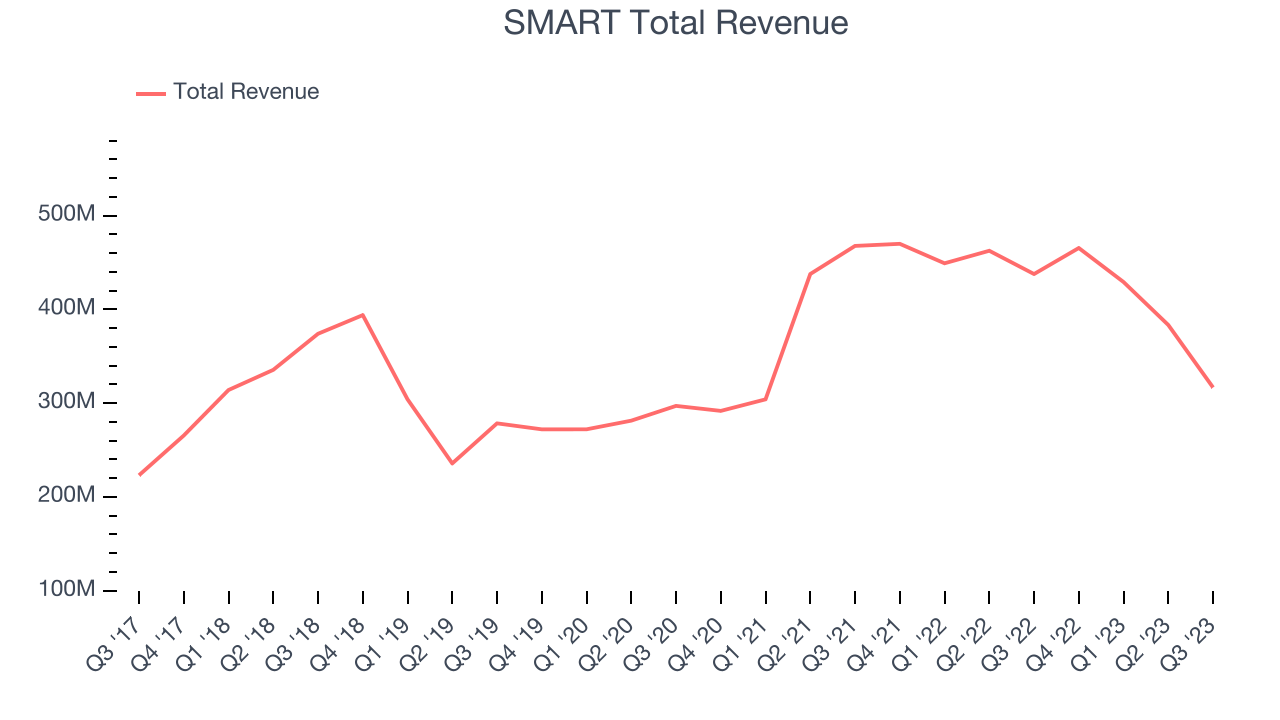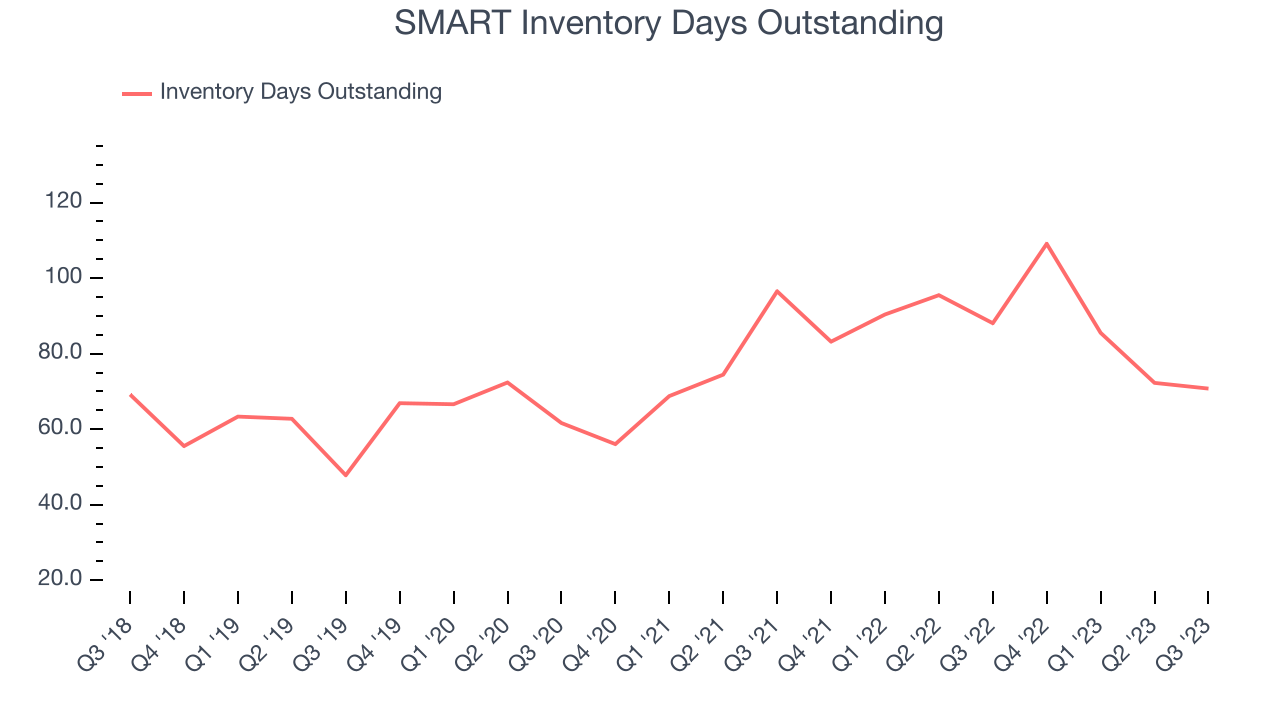Semiconductor maker SMART Global Holdings (NASDAQ:SGH) fell short of analysts' expectations in Q4 FY2023, with revenue down 27.7% year on year to $316.7 million. Turning to EPS, SMART made a GAAP profit of $1.17 per share, improving from its profit of $0.39 per share in the same quarter last year. Note that because of SMART's recent divestiture of SMART Modular Brazil in June 2023, the historical financials in our report may not match what the company disclosed in its latest press release. Until a full restatement of historical financials is shared with investors, we'll be comparing the company's performance to its historical financials at the time of reporting (which includes SMART Modular Brazil's financials).
Is now the time to buy SMART? Find out by accessing our full research report, it's free.
SMART (SGH) Q4 FY2023 Highlights:
- Revenue: $316.7 million vs analyst estimates of $375 million (15.6% miss)
- EPS (non-GAAP): $0.35 vs analyst expectations of $0.45 (23.1% miss)
- Revenue Guidance for Q1 2024 is $275 million at the midpoint, below analyst estimates of $384.7 million
- Free Cash Flow of $29.1 million, similar to the previous quarter
- Inventory Days Outstanding: 71, down from 72 in the previous quarter
- Gross Margin (GAAP): 28.9%, up from 23.7% in the same quarter last year
“Throughout fiscal 2023 the team has made significant progress in our transformational journey towards becoming an enterprise solutions company focused on higher quality revenue and improving gross margins. In the fourth quarter, in what remains a challenging global economic environment, non-GAAP gross margin increased to 31.7%, an improvement of 460 basis points from the same period last year, and non-GAAP earnings were $0.35 per share. In addition, we exited the fourth quarter with a strong balance sheet, including cash, cash equivalents and short term investments of $391 million,” commented the Company’s CEO Mark Adams.
Based in the US, SMART Global Holdings (NASDAQ:SGH) is a diversified semiconductor company offering memory, digital, and LED products.
Processors and Graphics Chips
The biggest demand drivers for processors (CPUs) and graphics chips at the moment are secular trends related to 5G and Internet of Things, autonomous driving, and high performance computing in the data center space, specifically around AI and machine learning. Like all semiconductor companies, digital chip makers exhibit a degree of cyclicality, driven by supply and demand imbalances and exposure to PC and Smartphone product cycles.
Sales Growth
SMART's revenue growth over the last three years has been mediocre, averaging 15.8% annually. But as you can see below, its revenue declined from $437.7 million in the same quarter last year to $316.7 million. Semiconductors are a cyclical industry, and long-term investors should be prepared for periods of high growth followed by periods of revenue contractions (which can sometimes offer opportune times to buy).

SMART had a difficult quarter as revenue dropped 27.7% year on year, missing analysts' estimates by 15.6%. This could mean that the current downcycle is deepening.
SMART's revenue growth has slowed over the last three quarters and its management team projects growth to turn negative next quarter. As such, the company is guiding for a 40.9% year-on-year revenue decline, but Wall Street thinks there will be a recovery next year. Analysts' estimates call for 12.7% growth over the next 12 months.
Our recent pick has been a big winner, and the stock is up more than 2,000% since the IPO a decade ago. If you didn’t buy then, you have another chance today. The business is much less risky now than it was in the years after going public. The company is a clear market leader in a huge, growing $200 billion market. Its $7 billion of revenue only scratches the surface. Its products are mission critical. Virtually no customers ever left the company. You can find it on our platform for free.
Product Demand & Outstanding Inventory
Days Inventory Outstanding (DIO) is an important metric for chipmakers, as it reflects a business' capital intensity and the cyclical nature of semiconductor supply and demand. In a tight supply environment, inventories tend to be stable, allowing chipmakers to exert pricing power. Steadily increasing DIO can be a warning sign that demand is weak, and if inventories continue to rise, the company may have to downsize production.

This quarter, SMART's DIO came in at 71, which is 4 days below its five-year average. At the moment, these numbers show no indication of an excessive inventory buildup.
Key Takeaways from SMART's Q4 Results
With a market capitalization of $1.21 billion, SMART is among smaller companies, but its $390.8 million cash balance and positive free cash flow over the last 12 months give us confidence that it has the resources needed to pursue a high-growth business strategy.
We were impressed by SMART's gross margin improvement this quarter. We were also glad its inventory levels shrunk. These factors can be attributed to the company's divestiture of SMART Modular Brazil, of which it owned 81%. The divestiture was announced in June 2023 and valued the company at an enterprise value of $205 million. Divestitures sometimes lead to messy financials and unclear guidance in the near term, and SMART is no exception. This was the first quarter after the divestiture was announced, and hence its revenue missed Wall Street's estimates and guidance underwhelmed. Overall, the results could have been better and investors are likely confused/unsure about the company's future given the situation. SMART is down 23.6% after reporting and currently trades at $18 per share.
SMART may have had a tough quarter, but does that actually create an opportunity to invest right now? When making that decision, it's important to consider its valuation, business qualities, as well as what has happened in the latest quarter. We cover that in our actionable full research report which you can read here, it's free.
One way to find opportunities in the market is to watch for generational shifts in the economy. Almost every company is slowly finding itself becoming a technology company and facing cybersecurity risks and as a result, the demand for cloud-native cybersecurity is skyrocketing. This company is leading a massive technological shift in the industry and with revenue growth of 50% year on year and best-in-class SaaS metrics it should definitely be on your radar.
Join Paid Stock Investor Research
Help us make StockStory more helpful to investors like yourself. Join our paid user research session and receive a $50 Amazon gift card for your opinions. Sign up here.
The author has no position in any of the stocks mentioned in this report.
